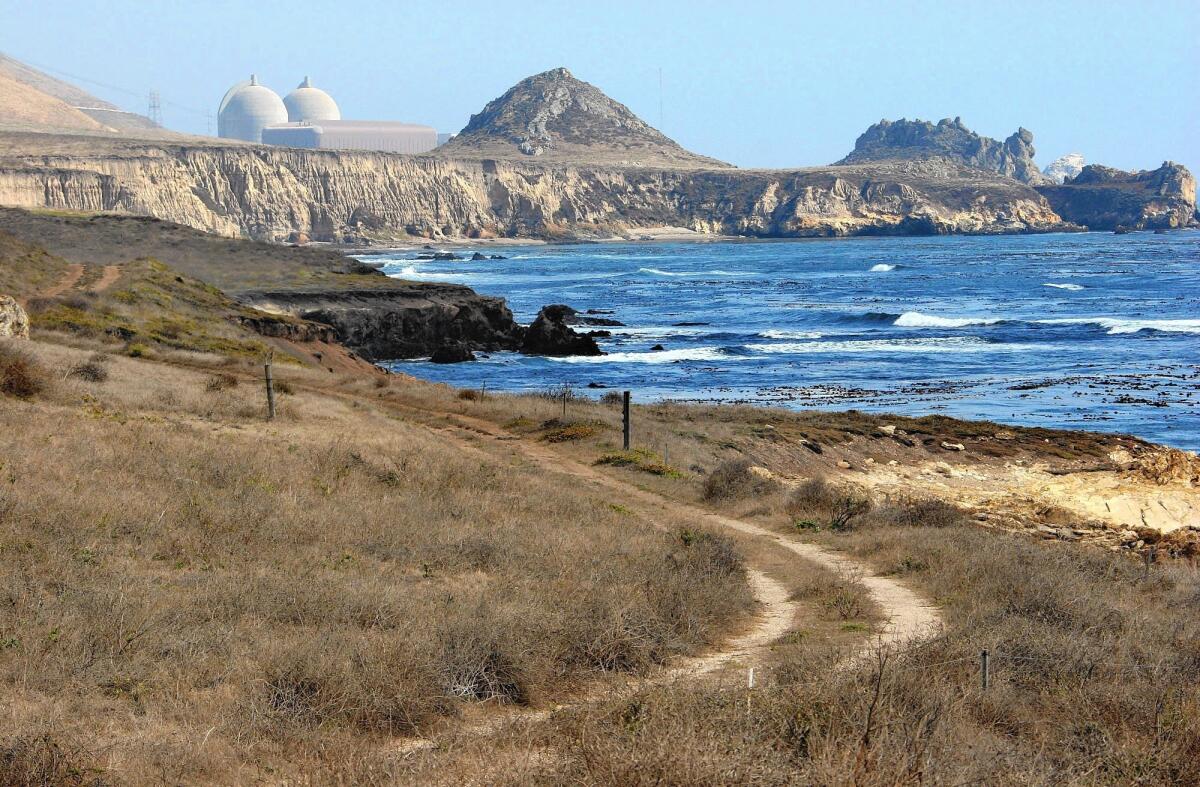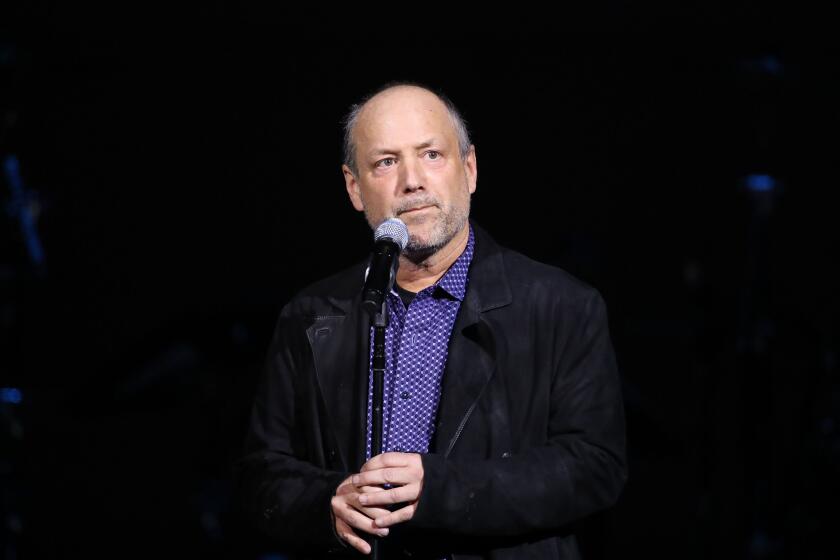PG&E plays coy on the future of Diablo Canyon nuclear plant

- Share via
California’s pioneering role in nuclear power started in 1957, when Southern California Edison powered up the nation’s first civilian commercial nuclear plant at Santa Susana to provide electricity to the neighboring city of Moorpark. That 60-year history may be coming to an end.
Its fate rests with the state’s last operating nuclear plant, Pacific Gas & Electric’s Diablo Canyon plant, located on the Pacific coastline in San Luis Obispo County. The original 40-year federal licenses for the plant’s two units expire in 2024 and 2025, and PG&E has been dithering over whether to pursue extensions covering an additional 20 years.
More than just the future of Diablo Canyon lies in limbo. The plant’s generating capacity of 2,160 megawatts affects the development of the state’s renewable electric resources. Although PG&E has asserted that the plant’s continued operation would save its customers as much as $16 billion during the additional 20 years, the cost of bringing Diablo Canyon into compliance with environmental and seismic mandates may in fact not be worth the effort.
Energy regulators and advocates have few clues to whether PG&E’s goal is to seek Diablo Canyon’s renewal or find an easy excuse for shutting it down early. “They’re so cagey about the future that I can’t help thinking there’s a strategy here,” says Matthew Freedman, a staff attorney for the consumer watchdog group Turn.
Freedman believes the utility’s intention is to delay the renewal proceeding long enough to hamper any opposition. In 2007, the state Public Utilities Commission directed the utility to decide whether to seek renewal at least 10 years in advance of the license expirations, so energy planners would have time to figure out how to replace Diablo Canyon’s output if the plant went dark. Waiting much longer would be “reckless and gambling with the public interest,” the PUC said. That moment is now.
PG&E placed its 2010 renewal application on hold after the Fukushima nuclear accident in 2011 “and has not set a timeline for a decision,” PG&E spokesman Blair Jones said.
As recently as mid-November, PG&E Chairman and CEO Anthony F. Earley Jr. told the San Francisco Chronicle, “We’ve got a lot on our plates, and we just don’t need to take on another big public issue right now.” His references were obvious: The utility is still laboring under the fallout from its 2010 San Bruno pipeline explosion, which killed eight people and has led to $2.2 billion in state fines and a federal indictment on dozens of criminal counts. Doubts about whether PG&E’s corporate culture is capable of managing a fast-food storefront, much less a major nuclear power plant situated near dangerous earthquake faults, are rife. “There’s a very troubled safety culture at PG&E demonstrated by San Bruno that carries over to Diablo Canyon,” says Daniel O. Hirsch, a lecturer on nuclear policy at UC Santa Cruz.
Operational failures and bad economics consistently have bedeviled the state’s nuclear utilities, as they have the nuclear industry nationwide. Edison’s Santa Susana reactor suffered a partial meltdown just two years into its operation, though it continued operating until 1964; a fight over how to clean up the contaminated site is still going on. In 1976, PG&E shut down its Humboldt Bay nuclear plant in Eureka, which had gone online in 1963, to avoid the expense of a required seismic upgrade. The $125-million cost of required improvements also doomed Edison’s San Onofre unit 1, which operated from 1968 to 1992. Units 2 and 3 opened in 1983 and 1984, went dark in January 2012 after extreme wear was found in newly installed generators, and never relaunched. They were permanently retired June 2013. Edison and the PUC are still fighting over how much to saddle Edison customers for the premature shutdown.
Diablo Canyon was controversial from the start. The Hosgri earthquake fault was discovered three miles from the site after federal regulators already had approved construction in 1968 and 1970. Among its most prominent opponents after the Three Mile Island meltdown in 1979 was the then-governor of California, Jerry Brown. After a seismic retrofit in 1981, it was discovered that part of the upgrade was installed backward because the blueprints had been reversed. Originally budgeted at $380 million, the plant cost $5.52 billion by the time it was finished, Friends of the Earth observed in a 2014 filing with the PUC.
Complicating the question of Diablo Canyon’s future are several state mandates due for rulings this year. The State Water Resources Control Board has outlawed “once-through cooling,” the technology employed at Diablo Canyon, because of its severe effects on marine wildlife. The power plant “causes 80% of all the serious harm to marine life from all of the coastal power plants” in the state, Friends of the Earth says. The utility, which maintains that “Diablo Canyon’s operations have a minimal impact on marine life,” is hoping to stave off application of the rule to the plant, where replacing the cooling system could cost as much as $11 billion.
Meanwhile, the State Lands Commission is pondering whether to extend leases for the plant’s water intake and discharge structures, which expire in 2018 and 2019. Lt. Gov. Gavin Newsom, a member of that body, recently called for a thorough environmental review of Diablo Canyon before any action is taken.
Looming over all these issues are doubts about whether Diablo Canyon’s electrical output is even needed over the middle or long term. California as a whole is oversupplied with electrical resources by more than 40%, according to the California Independent System Operator, which manages the long-distance power lines serving about 80% of the state. But some energy experts say the continued operation of Diablo Canyon may hamper the development of renewable energy in California because the plant’s inflexible output reduces demand, and therefore the economic rationale, for solar and wind power. “Achieving California’s 2030 greenhouse gas goals may prove impossible if you place false reliance on Diablo Canyon,” former California Energy Commissioner John Geesman told a PUC workshop last month.
As long as PG&E keeps its options open, the state’s progress toward a sustainably carbon-free energy grid remains in suspended animation. It’s time for PG&E to decide what to do with Diablo Canyon, and more important, share its thinking with the rest of us.
If California’s history with nuclear power really is coming to an end, there’s no point in putting off the reckoning.
Michael Hiltzik’s column appears every Sunday. His new book is “Big Science: Ernest Lawrence and the Invention That Launched the Military-Industrial Complex.” Read his blog every day at latimes.com/business/hiltzik, reach him at mhiltzik@latimes.com, check out facebook.com/hiltzik and follow @hiltzikm on Twitter.
More to Read
Inside the business of entertainment
The Wide Shot brings you news, analysis and insights on everything from streaming wars to production — and what it all means for the future.
You may occasionally receive promotional content from the Los Angeles Times.











